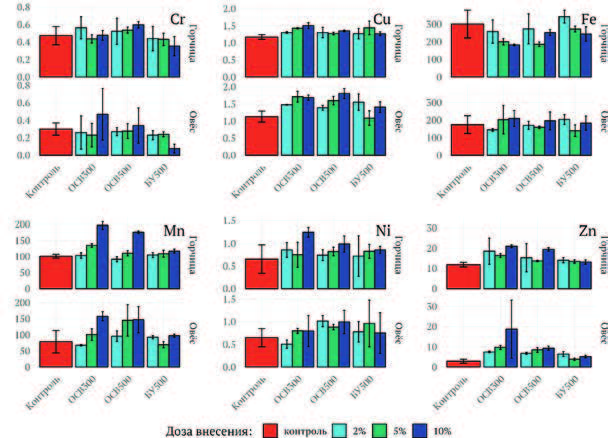Нeavy metals content in plants after an application of different types of biochar into the grey forest soil
Keywords:
biochar, soil, heavy metals, safety of agricultural productsAbstract
The issue of sewage sludge disposal in Russian Federation is one of the most urgent problems of ensuring environmental safety of the territories. Their direct use as fertilizers leads to long-term contamination of soil with heavy metals and, as a result, agricultural products do not meet sanitary standards. Pyrolysis in the process of biochar production contributes to the transition of heavy metals to stable forms and is recognized as a promising way of sewage sludge disposal. The aim was to assess the impact of adding different doses of three types of biochar on the heavy metals content (Cr, Cu, Fe, Mn, Ni, and Zn) in vegetative biomass of mustard and oat plants. The results showed that the addition of low-temperature biochar from sewage sludge into soil leads to a significant increase in the concentrations of Cu, Mn and Zn in mustard and oat, and the addition of high-temperature biochar - to an increased content of Mn. Birch biochar did not show any significant effect on metal content in the plants under test.
References
GN 2.1.7.2041-06. Predel'no dopustimye kontsentratsii (PDK) khimicheskikh veshchestv v pochve: Gigienicheskie normativy [Maximum Permissible Concentrations (MPC) of Chemicals in Soil: Hygienic Regulations].
GN 2.1.7.2511-09. Orientirovochno dopustimye kontsentratsii (ODK) khimicheskikh veshchestv v pochve: Gigienicheskie normativy. [Approximate Acceptable Concentrations (AAC) of Chemicals in Soil: Hygienic Regulations].
GOST R 17.4.3.07-2001. Okhrana prirody. Pochvy. Trebovaniya k svoystvam osadkov stochnykh vod pri ispol'zovanii ikh v kachestve udobreniy [Nature protection. Soils. Requirements for the properties of sewage sludge when used as fertilizer].
Grachev A.N., Bashkirov V.N., Zabelkin S.A., Makarov A.A., Tuntsev D.V., Khismatov R.G. Patent RF №2395559. Sposob termicheskoy pererabotki organosoderzhashchego syr'ya. [The patent of the Russian Federation №2395559. Method of thermal processing of organ-containing raw materials].
Plekhanova I.O. Stepen' samoochishcheniya agrodrnovo-podzolistykh supeschanykh pochv, udobrennykh osadkom stochnykh vod [Degree of self-purification of agrarian sod-podzolic sandy loam soils fertilized with sewage sludge] // Pochvovedenie [Soil Science]. 2017. No 4. P. 506‒512. DOI: 10.7868/S0032180X17040086.
PND F 16.2.2.2.3.71-2011. Kolichestvennyy khimicheskiy analiz pochv. Metodika izmereniy massovykh doley metallov v osadkakh stochnykh vod, donnykh otlozheniyakh, obraztsakh rastitel'nogo proiskhozhdeniya spektral'nymi metodami. [Quantitative chemical analysis of soils. Methods of measuring mass fraction of metals in sewage sludge, sediments, samples of plant origin by spectral methods].
RD 52.18.191-89. Metodika vypolneniya izmereniy massovoy doli kislotorastvorimykh form metallov (medi, svintsa, tsinka, nikelya, kalmiya) v probakh pochvy atomno-absorbtsionnym analizom. [Methods of measuring the mass fraction of acid-soluble forms of metals (copper, lead, zinc, nickel, calcium) in soil samples by atomic absorption analysis].
RD 52.18.289-90. Metodika vypolneniya izmereniy massovoy doli podvizhnykh form metallov (medi, svintsa, tsinka, nikelya, kadmiya, kobal'ta, khroma, margantsa) v probakh pochvy atomno-absorbtsionnym analizom [Methods for measuring the mass fraction of mobile metal forms (copper, lead, zinc, nickel, cadmium, cobalt, chromium, manganese) in soil samples by atomic absorption analysis].
Rizhiya E.Ya., Buchkina N.P., Mukhina I.M., Belinets A.S., Balashov E.V. Vliyanie biouglya na svoystva obraztsov dernovo-podzolistoy supeschanoy pochvy s raznoy stepen'yu okul'turennosti (laboratornyy eksperiment) [Influence of biochar on the properties of samples of sod-podzolic sandy loam soil with different degree of cultivation (laboratory experiment)] // Pochvovedenie [Soil Science]. 2015. No 2. P. 211‒220. DOI: 10.7868/S0032180X14120089.
Ryazanov S.S., Kulagina V.I., Grachev A.N., Solodnikova O.M., Sungatullina L.M. Vliyanie temperatury piroliza osadkov munitsipal'nykh stochnykh vod na formy tyazhelykh metallov (Cu, Ni, Pb) [Influence of pyrolysis temperature of municipal sewage sludge on heavy metal forms (Cu, Ni, Pb)] // Ekologicheskie problemy razvitiya agrolandshaftov i sposoby povysheniya ikh produktivnosti [Environmental problems of agro-landscape development and ways to increase their productivity] / Sbornik statey po materialam Mezhdunarodnoi nauchoi ekologicheskoi konferencii. Krasnodar: KubGAU, 2018. S. 31-33.
Song X.D., Xue X.Y., Chen D.Z., He P.J., Dai X.H. Application of biochar from sewage sludge to plant cultivation: Influence of pyrolysis temperature and biochar-to-soil ratio on yield and heavy metal accumulation // Chemosphere. 2014. Vol. 109. P. 213‒220. DOI: 10.1016/j.chemosphere.2014.01.070.
ISO 11466:1995. Soil quality - Extraction of trace elements soluble in aqua regia.
Jin J., Li Y., Zhang J., Wu S., Cao Y., Liang P., Zhang J., Wong M.H., Wang M., Shan S., Christie P. Influence of pyrolysis temperature on properties and environmental safety of heavy metals in biochars derived from municipal sewage sludge // Journal of hazardous materials. 2016. Vol. 320. P. 417‒426. DOI: 10.1016/j.jhazmat.2016.08.050.
Major J. Guidelines on Practical Aspects of Biochar Application to Field Soil in Various Soil Management Systems. International Biochar Initiative, 2010. 23 p.
Gunten K. von, Alam Md.S., Hubmann M., Ok Y.S., Konhauser K.O., Alessi D.S. Modified sequential extraction for biochar and petroleum coke: Metal release potential and its environmental implications // Bioresource Technology. 2017. Vol. 236. P. 106-110. DOI: 10.1016/j.biortech.2017.03.162.





